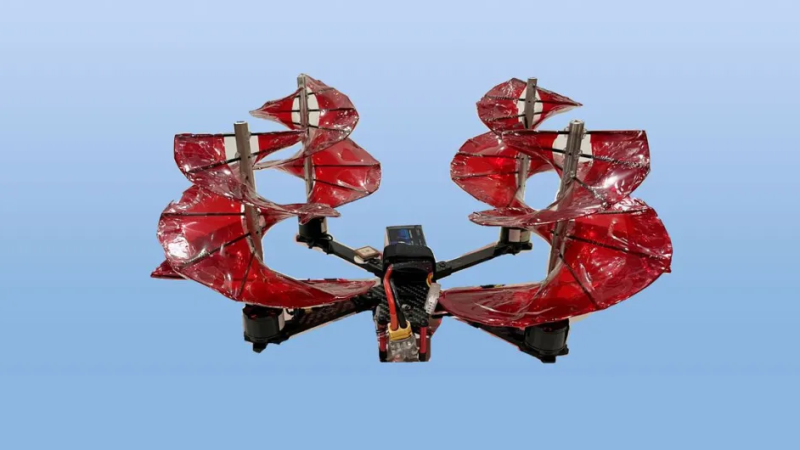For as much of a genius as Leonardo da Vinci obviously was, modern eyes looking upon his notebooks from the 1400s tend to see his designs as somewhat quaint. After all, his concept of a vehicle armored with wood would probably only have survived the archers and pikemen of a Renaissance battlefield, and his curious helicopter driven by an Archimedes screw would certainly never fly, right?
Don’t tell that to [Austin Prete] and his team from the University of Maryland, who’ve built a da Vinci-style quadcopter that actually flies. Called the “Crimson Spin”, the quad is based on a standard airframe and electronics. Details are sparse — the group just presented the work at a vertical flight conference — but it appears the usual plastic props are replaced with lightweight screws made from wire and some sort of transparent plastic membrane. Opposing pairs of screws have the opposite handedness, which gives the quad yaw control. There’s a video embedded in the link above that shows the quad being tested both indoors and out, and performing surprisingly well. We’d imagine that Crimson Spin might not do so well on a windy day, given the large wind cross-section those screws present, but the fact it got off the ground at all is cool enough. It kind of makes you wonder where we’d be today if da Vinci had access to BLDCs.
For as fanciful as da Vinci’s designs can be, we’ve seen a fair number of attempts to recreate them in modern materials. His cryptex is a perennial favorite for hackers, and his bizarre piano-esque “viola organista” has been attempted at least once.
Thanks to [Peter Ryseck] for this tip.
















It probably would have been easier to 3D print these props.
I don’t think it would have been, at least not useable ones – FDM prints would have to be pretty heavy to have the part thickness to work with the minium wall thickness of the printer (and would probably still fly apart – high speed rotating 3d prints are quite tricky and tend to fail with no warning and explosively in my experience) and resin prints tend to brittle to the point such thin structures are probably too weak to deal with their own air resistance and inertia at all (there are tougher UV resins but I don’t know of any that could really do this job from their material properties sheet (if they have one))… And even the Injection molded nylon type thin detailed durability powder melt printers can create would still suffer from the weight issue I expect…
Cosmetic ones would be easy, and I expect you can design for either common 3d print tech and make it functional after a few iteration, with careful material selection and very delicate use. The fused powder 3d printer I have no doubt could create functional ones that might actually survive use, however I don’t think it would be as effective or easy as this method really…
p.s. Don’t get me wrong I do have a great deal of love for 3d prints, they are capable of being way more than just cosmetic parts, it is just this part, to me at least, with its thin spiral is not a good fit at all. Heck even injection molded plastic in such a shape would end up too weedy or heavy on its own to really work as well as this does IMO.
i can only imagine the look of joy on leo’s face if they saw this thing take off and fly!
Perhaps it not appropriate to refer to the cryptex as “His” (DaVinci’s), considering that it is only ascribed to him by the fictional “The DaVinci Code,” and actually devised by that book’s author.
This is noted in the ’17 Hackaday article that you link, but not everyone is going to actually click through and see that.
This quad aero-screw is beautiful though. As a child, I always wished that this mechanism could be made functional, and it looks like miniaturization, lithium batteries, and the drive to finish your master’s degree have finally done so. I wonder just how much less efficient it is than a more standard equivalent. :)
Is this an ID10T user event or is there no video of this thing? All I’ve found are 3d renders. Not even a photo.
There’s a video on the linked CNET article …
I think it could fly well in the wind. When hhe wind would make a screw spin faster the computer would compensate by reducing the power in the affected screw.